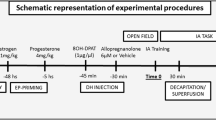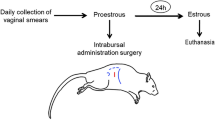Abstract
1. The neurosteroids are compounds derived from steroid hormones and synthesized in the nervous system. They can modulate different neurotransmitter pathways. In previous work we demonstrated that progesterone modulates dopamine release induced by the glutamatergic agonist N-methyl-D-aspartic acid (NMDA).
2. The aim of this work was to evaluate a possible modulatory role of the progesterone metabolite allopregnanolone on NMDA-evoked [3H]dopamine release from corpus striatum slices obtained from cycling and ovariectomized female rats.
3. We used a dynamic superfusion method to evaluate the release of [3H]dopamine. Allopregnanolone at 50–600 nM was added to the superfusion buffer (Krebs–Ringer–bicarbonate–glucose, pH 7.4, with constant O2/CO2 gassing). The results are expressed as a percentage over basal [3H]dopamine loaded by the tissue.
4. Allopregnanolone (50 and 100 nM) increased the NMDA-evoked[3H]dopamine release from estrus rats. The remaining doses did not show significant changes in the pattern of release. This effect was not observed in diestrus rats. The ovariectomy abolished the facilitatory effect of allopregnanolone on NMDA-evoked 2 [3H]dopamine release.
5. Subcutaneous administration of exogenous estrogen (25 mg/rat) and progesterone (1 mg/rat) restored the facilitatory effect on dopaminergic input.
6. These results suggest that allopregnanolone is a neurosteroid able to modulate dopamine release in an ovarian-hormone-fluctuation-dependent manner and provide further support for a role of allopregnanolone as a modulator of glutamatergic–dopaminergic interaction in the corpus striatum.
Similar content being viewed by others
REFERENCES
Becker, J. B., and Rudick, C. N. (1999). Rapid effects of estrogen or progesterone on the amphetamine induced increase in striatal dopamine are enhanced by estrogen priming: A microdialysis study. Pharmacol. Biochem. Behav. 64:53–57.
Belmar, J., Cuellar, C., Llona, I., Arancibia, S., Kusch, C., Tapia, L., Pinter, A., and Pérez, H. (1998). Allopregnanolone-induced modifications of presynaptic basal and Kp+-induced p3H-norepinephrine efflux from rat cortical slices during the estrus cycle. Neuroendocrinolgy 68:264–271.
Cabrera, R. J., and Bregonzio, C. (1996). Turnover rate and stimulus-evoked release of dopamine by progesterone and N-methyl-D-aspartic acid in rat striatum during pregnancy. Eur. J. Pharmacol. 317:55–59.
Cabrera, R. J., Diaz, A., Pinter, A., and Belmar, J. (1993). In vitro progesterone effects on3H-dopamine release from rat corpus striatum slices obtained under different endocrine conditions. Life Sci. 53:1767–1777.
Cabrera, R. J., and Navarro, C. E. (1996). Progesterone in vitro increases NMDA-evoked p3H-dopamine release from striatal slices in proestrus rats. Neuropharmacology 35:175–178.
Caligaris, L., Astrada, J. J., Taleisnik, S. (1972). Effect of oestrogen and progesterome on the release of luteinizing harmone in pseudo pregnant rats. Acta. Endocrinol. 70: 163–6.
Campagnone, N. A., and Mellon, S. H. (2000). Neurosteroids: Biosynthesis and function of these novel neuromodulators. Front. Neuroendocrinol. 21:1–56.
Concas, A., Follesa, P., Barbaccia, M. L., Purdy, R. H., and Biggio, G. (1999). Physiological modulation of GABA(A) receptor plasticity by progesterone metabolites. Eur. J. Pharmacol. 375:225–235.
Copérchot, C., Young, J., Cavel, M., Wehrey, C., Veltz, J.N., Touyer, G., Mouren, M., Prasad, V.V., Banner, C., Sjovall, J., Baulieu, E. E., and Robel, P. (1993). Neurosteroids: 3®-hydroxy-5®-pregnan-20-one and its precursors in the brain, plasma, and steroidogenic glands of male and female rats. Endocrinology 133:1003–1009.
García-Segura, L. M., Chowen, J. A., and Naftolin, F. (1996). Endocrine glia: Roles of glial cells in the brain actions of steroids and thyroids hormones and in the regulation of hormone secretion. Front. Neuroendocrinology 17:180-211.
Genazzani, A. R., Stomati, M., Morittu, A., Bernardi, F., Monteleone, P., Casarosa, E., Gallo, R., Salvestroni, C., and Luisi, M. (2000). Progesterone, progestagens and the central nervous system. Hum. Reprod. 15:14–27.
Kompoliti, K., Comella, C. L., Jaglin, J. A., Leurgans, S., Raman, R., and Goetz, C. G. (2000). Menstrualrelated changes in motoric function in women with Parkinson's disease. Neurology 55(10):1572–1575.
Krebs, M. O., Desce, J. M., Kemel, M. L., Gauchi, C., Godeheu, G., Cheramy, A., and Glowisnki, J. (1991). Glutamatergic control of dopamine release in rat striatum: Evidence for presynaptic aspartate receptors on dopaminergic nerve terminals. J. Neurochem. 56:81–85.
Kretschmer, B. D. (1999). Modulation of the mesolimbic dopamine system by glutamate: Role of NMDA receptors. J. Neurochem. 73:839–848.
Lan, N. C., Gee, K., Bolger, M. B., and Chen, J. S. (1991). Differential responses of expressed combinant human GABA receptors to neurosteroids. J. Neurochem. 57:1818–1821.
Mahesh, V. B., Brann, D. W., and Hendry, L. B. (1996). Diverse modes of action of progesterone and its metabolites. J. Steroid Biochem. Mol. Biol. 56:209–219.
Majewska, M.D. (1992). Neurosteroids: Endogenous bimodal modulators of theGABApA receptor. Mechanism of action and physiological significance. Prog. Neurobiol. 38:379–395.
Mc Ewen, B. S. (1991). Non-genomic effects of steroids on neural activity. Trends Pharmacol. Sci. 12:141–147.
Meyer, J. H., and Gruol, D. L. (1994). Dehydroepiandrosterone sulfate alters synaptic potentials in area CA1 of the hippocampal slice. Brain Res. 633:253–261.
Minami, T., Oomura, Y., Nabekura, J., and Fukuda, A. (1990). 17-β-Estradiol depolarization of hypothalamic neurons is mediated by cyclic AMP. Brain Res. 519:301–307.
Mizuta, E., Yamasaki, S., Nakatake, M., and Kuno, S. (1993). Neuroleptic malignant syndrome in a parkinsonian woman during the premenstrual period. Neurology 43(5):1048–1049.
Morari, M., Marti, M., Sbrenna, S., Fuxe, K., and Beani, L. (1998). Reciprocal dopamine–glutamate modulation of release in the basal ganglia. Neurochem. Int. 33:383–397.
Quinn, N. P., and Marsden, C. D. (1986). Menstrual-related fluctuations in Parkinson's disease. Mov. Disord. 1(1):85–87.
Ram´rez, V. D., Dluzen, D. E., and Ke, F. C. (1990). Steroid and neuronal activity. In Chadwick, D., Widdows, K. (eds.), Ciba Foundation Symposium 153,Wiley, New York, pp. 125–144.
Revelli, A., Tesarik, J., and Massobrio, M. (1998). Nongenomic effects of neurosteroids. Gynecol. Endocrinol. 12:61–67.
Roberts, E. (1995). Pregnenolone from Selye to Alzheimer and a model of pregnenolone sulfate binding site on GABA A receptor. Biochem. Pharmacol. 6:49, 1–16.
Ruprecht, R. (1996). Neurosteroids: Molecular mechanism of action and psychopharmacological signifi-cance. J. Steroid Biochem. Mol. Biol. 56:163–168.
Selye, H. (1942). Correlations between the chemical structure and pharmacological actions of steroids. Endocrinology 30:437–453.
Spindler, K. D. (1997). Interactions between steroid hormones and the nervous system. Neurotoxicolgy 18:745–754.
Strijks, E., Kremer, J. A., and Horstink, M.W. (1999). Effects of female sex steroids on Parkinson's disease in postmenopausal women. Clin. Neuropharmacol. 22(2):93–97.
Westerink, B. H., Santiago, M., and De Vries, J. B. (1992). The release of dopamine from nerve terminals and dendrites of nigrostriatal neurons induced by excitatory amino acids in the concious rat. Arch. Pharmacol. 345:523–529.
Wu, F. S., Gibbs, T. T., and Farb, D. H. (1991). Pregnenolone sulfate: A positive allosteric modulator at the N-methyl-D-aspartate receptor. Mol. Pharmacol. 40:333–336.
Zwain, I. H., and Yen, S. S. (1999). Neurosteroidogenesis in astrocytes, oligodendrocytes, and neurons of cerebral cortex of rat brain. Endocrinology 140:3843–3852.
Author information
Authors and Affiliations
Rights and permissions
About this article
Cite this article
Cabrera, R.J., Bregonzio, C., Laconi, M. et al. Allopregnanolone Increase in Striatal N-Methyl-D-aspartic Acid Evoked [3H]Dopamine Release Is Estrogen and Progesterone Dependent. Cell Mol Neurobiol 22, 445–454 (2002). https://doi.org/10.1023/A:1021015705597
Issue Date:
DOI: https://doi.org/10.1023/A:1021015705597




